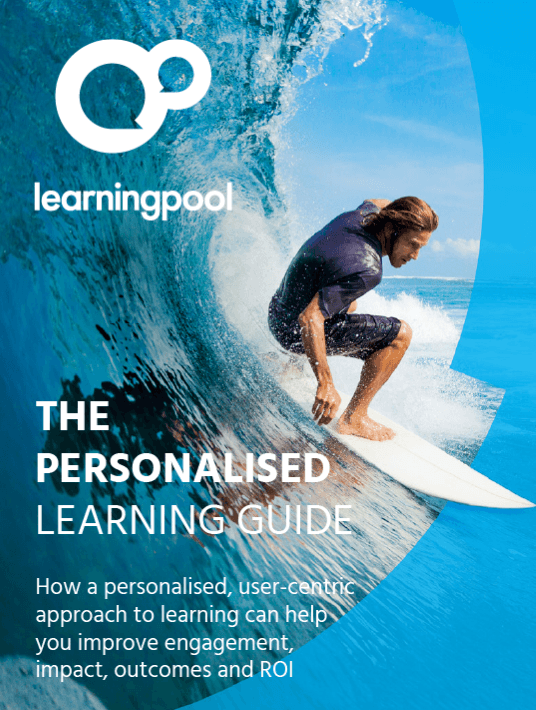Investing In A Personalised Learning LXP To Deliver Impact And ROI
1. Greater Independence Of Learning
The personalisation of learning leads to greater learner independence. Instead of waiting to be trained an employee can work and learn at the same time. The LXP environment is designed to encourage self-sufficiency. Using AI recommender systems and the collaborative culture of social media it helps learners manage their own learning in a fail-safe environment, supported by fellow employees and L&D.

Recommendations through likes, comments, and posts help establish a continuous feedback loop. Learners receive suggestions on what they need to learn and study via choices made by their peers. A notification system alerts them to new content, reminds them of key milestones, recommends refresher training. This system of mutual evaluation keeps the content fresh and alerts L&D to gaps that need filling while enabling greater learner independence and improving the relevance of what they’re learning.
From the organisation’s point of view, you have employees learning as they work and learning just what they need to know to do that work. Instead of having to drive learners, they’re taking up the reins themselves. This makes learning objectives more focused and less aspirational and makes training more relevant and learners self-motivated and engaged.
2. Learning In Workflow
The effect of this greater learner independence is to move learning closer to the sphere of work.
Breaking down the artificial barriers between training and working is one of the biggest learning outcomes from the introduction of personalised learning. Learners begin to see that learning is part of work, and not something you need to have consumed before you act.
3. Collaborative Learning
The emphasis of personalised learning is on the individual learner, but one of the consequences of implementing a personalised learning strategy with an LXP is the growth of collaborative learning. LXPs facilitate and encourage the sharing of knowledge, whether it be in uploading learner-generated content, posts or feedback and likes. The LXP works like a social media platform, accommodating personal preferences and encouraging personal connections.
But when aggregated, this sharing of knowledge and information between individual learners amounts to a valuable repository of in-house expertise. So instead of seeing valuable information trapped in the heads of experienced employees, there’s now a way and a culture to liberate and share that experience and knowledge for the benefit of all. It has the potential to create a new culture of learning in the organisation.
4. Efficiency Economies
LXPs bring learning into the workflow, breaking down the barriers between work and training. They allow for the re-use and re-purposing of existing content, but also make it more digestible using a microlearning approach. This extends the ROI of both bought-in and bespoke content.
The option of incorporating content created and curated by in-house experts makes for further savings. And, as L&D shifts closer to the workplace there’s scope for greater efficiencies with the creation of more relevant learning materials and the prospect of more targeted interventions for individual learners.
How To Choose Your LXP
Not all LXPs are created equal. In fact, there’s a lot of diversity out there, and also hybrid LXP/LMS solutions. So how do you choose the best LXP to support personalised learning within your organisation?
Here are 6 fundamental things you should look out for.
1. User-Friendly Interface And UX
Remember the LXP is for independent as well as prescribed learning, so learners need to feel in control and have everything at their fingertips. Nothing should be more than a couple of clicks away.
The best LXPs create an environment that mirrors the social media and entertainment apps we’ve become so accustomed to using. It should contain familiar collaborative features such as messaging, posting comments, recommendations, and likes, and making connections with other users. These facilities provide a support network within a safe and familiar environment for the learner.
2. Content Front And Centre
One of the key advantages of the LXP is the wide range of content it can offer and the adaptability of that content. Any good LXP will host articles, podcasts, links to external content, learner blogs, videos, all the way up to and including full eLearning courses.
3. User-Generated Content
LXPs should allow learners to make their own contributions, not simply in providing feedback or offering longer pieces of analysis, but also in creating and uploading their own content. Produce and upload your own quick video to your LXP home page and suddenly everyone has potential access to this nugget of wisdom.
4. Pathways To Learning
LXPs not only allow for greater individual choices but should also facilitate the aggregation of content in flexible ways.
For learners themselves, LXPs allow the creation of individual learning 'playlists.' As with any entertainment app, these feature your favourites, which in a learning context might be the go-to resources you need to support you in your day-to-day work. Or you might create another playlist of resources to prepare for a new task or role you’re being asked to perform.
L&D should be able to make use of this facility, too. They can identify small groups of learners who need to be trained quickly to meet a new challenge. Instead of building a new course from scratch, they can assemble relevant, existing resources to create a playlist or learning plan that fulfils the desired outcome.
The ultimate expression of the LXP’s adaptability and flexibility is in the creation of individual learner pathways which concentrate on the development of individual learners complete with milestones. LXPs should support digital badging to recognise formally the achievements and attainment of learners and which can be translated into learner credits recognised across the organisation.
5. Tracking And Reporting
A constant challenge for L&D is to evaluate its work, to demonstrate ROI and improvements in learner performance. LXPs should allow for the inclusion of a Learning Record Store (LRS). LRSs use xAPI to record data from a variety of learning activities, both formal and informal, allowing a data-driven analysis of what’s working and what isn’t.
Using xAPI statements L&D can get a much more granular view of learner activity. This makes evaluation much easier and places it on a sounder, more empirical footing.
6. Artificial Intelligence
Learners need assistance in making the best and most efficient use of the array of features and content on offer in an LXP. Search is key: the better LXPs offer a Google-grade search engine that will not only return results but suggest keyword searches and return answers in an easily accessible format.
AI-powered learnbots can also be integrated into the LXP environment (as covered in an earlier chapter) to act as a guide, mentor and personal assistant.
The intelligence in an LXP can also be configured by L&D. It can push notifications and recommendations to learners reminding them of deadlines and informing them of updated and new resources.
Making The Right Choice
This is far from an exhaustive features list, but these criteria provide key guidelines for choosing the right LXP and ensuring it supports personalised learning. Download the eBook The Personalised Learning Guide and discover how to frame a business case for personalized learning, and deploy appropriate technology to help implement it effectively. For more valuable insights on personalised learning, join the webinar.


